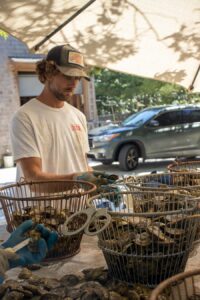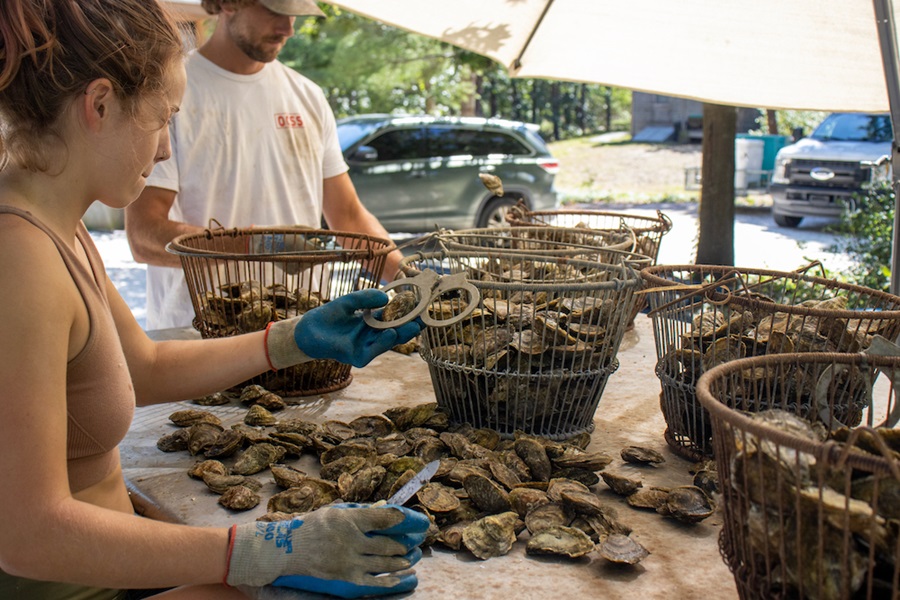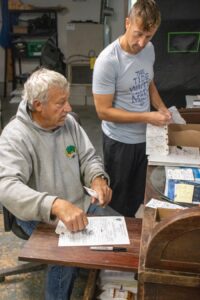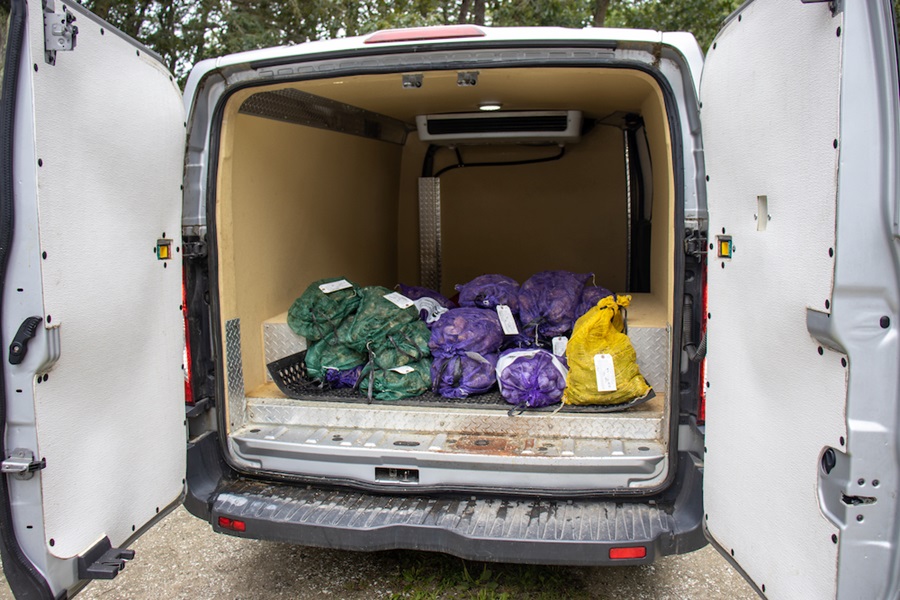WELLFLEET — Jimmy Mulpeter stands under the shade of a patio umbrella on an August afternoon, holding oyster after oyster against a metal gauge before tossing them into one of five buckets. He’s sorting them by size, and he works fast, picking up his pace when momentarily unobserved.
Mulpeter will sort about 30 bags today, somewhere between 5,000 and 10,000 oysters. The culling is one of several tasks he attends to when he’s off the tide, most of them accomplished in his uncle’s front yard. Mulpeter’s uncle is also his boss, longtime shellfisherman Jim O’Connell.

The off-site labor is never seen by most oyster eaters here, but it represents over 60 percent of the crew’s work day to day, O’Connell estimates.
The work of oyster farming is pretty much “perpetual,” says Nancy O’Connell, Jim’s wife and the president of the Wellfleet Oyster Alliance board. She’s watching Jim and her nephew cull from her front porch. Shellfishing is much more than the comings and goings people see on the flats, she says: “They’d be in 12-foot-deep water right now.”
The work done off the tide also offers a window into the economic paths shellfish follow before reaching people’s plates and the regulations that govern their journey. The rules aim to prevent outbreaks of disease, like the bacterial illnesses that prompted an Aug. 2 recall of oysters harvested in Lewis Bay in Hyannis between July 1 and 18.
Sorting and Tumbling
Any market-size oysters removed from a grant for culling or sorting between mid-May and mid-October of this year must be returned to the harvesting site and resubmerged on a segregated part of the grant for at least 10 days before being harvested, according to the 2024 Mass. Vibrio Control Plan. Vibrio is another bacterial illness.
Some farmers will cull on the tide in order to avoid the requirement to resubmerge their product, but doing so is impractical given the size of Mulpeter and O’Connell’s operation, Mulpeter says.
The tides, which render the flats workable for two to four hours at a time, make shellfish farming a constant fight against the clock. Clams need to be dug, nets need to be cleaned, and maintenance done, Mulpeter says.

“If you can do something at home, it’s nice,” he says. The sea and land combination means long days. Mulpeter began working around 5:15 a.m.; he expects to finish around 5 p.m.
“I used to crawl out of my skin just standing here doing this for so long,” he says of culling oysters. “Now I feel like I can just do it forever. It’s kind of like meditation.”
A rhythmic shaking comes from the building behind Mulpeter where Mimi Bois, a Provincetown-rooted sophomore at Bates College who works with O’Connell during school breaks, operates a tumbler, a long cylindrical machine designed to “grade” the farm’s smaller oysters by size. The device is composed of three joined rotating panels, each of which have slightly different-size holes through which the oysters fall into containers below.
Tumbling is an efficient way to sort oysters before they have reached market size. They are rebagged accordingly before going back on the flats to grow. Tumbling can also help shape the growing oysters, knocking off thin edges to strengthen their shells and ensure they grow deeper cups, according to Mulpeter.
At the front of the machine, Bois separates any oysters that have attached to one another before they enter the perforated tube. Occasionally tiny crabs mixed in with the pile of waiting shells scramble away. She pays them little attention.
Wholesale’s Not for Everyone
For Bob Wallace, who spends a portion of his morning at a desk filling out tags for the day’s shellfish, time spent off the flats looks different. Another longtime Wellfleet shellfisherman, Wallace intermittently stamps the tags — which include information like the date and location the shellfish were harvested — with the names of the restaurants they’re destined for: “Winslow’s, Pearl, VR,” they read.
The completed tags are placed on each 100-count bag of oysters inside a nearby walk-in refrigerator after being brought in off the tide.
In Massachusetts, shellfish farmers cannot sell directly to consumers. Instead, licensed wholesale dealers act as intermediaries. The wholesale dealers are subject to a variety of additional requirements, including the preparation of a Hazard Analysis of Critical Control Points, or HACCP, plan designed to “systematically identify and control known food safety hazards,” according to the Mass. Food Processors Resource Guide.

Harvesters can independently also act as wholesale dealers if they are properly licensed, but most choose not to do so, according to Wallace, who grows some of the oysters and clams sold to Billingsgate Shellfish, which he also manages.
The additional regulation and paperwork, including documenting his own self-dealing, yields some benefits, as his shellfish fetch the retail rather than the wholesale price.
In this role, Wallace sells shellfish to fewer than 10 restaurants, representing roughly 60 percent of his sales each year. The rest he sells to larger wholesalers, which matters most when his local restaurant customers are closed during the winter. The restaurant orders come in all night over text to his phone. He buys from himself as well as from his son, John Wallace, and a few other farmers to meet demand as necessary.
Selling directly to restaurants, which are particular about the size and shape of their oysters, adds another step to the off-the-tides work. One of the chefs on John Wallace’s delivery list wants oysters without sharp edges because he doesn’t want to wear gloves while preparing them. Wallace cuts the edges off to accommodate the request.

For other growers, particularly with larger farms, the logistical and paperwork challenges of the wholesale business are discouraging. Jacob Dalby, who previously both grew and sold oysters as a wholesale dealer under the name Holbrook Oyster, says the extra work wasn’t worth the return. Dalby and his former partner Zack Dixon recently split the business, and now Dalby is back to only farming.
“It’s hard to be a fisherman and a wholesale dealer because they’re two completely different businesses,” he says.
With more time to farm, increased productivity makes up for the perceived loss of getting wholesale instead of retail prices, according to Jake Puffer, another Wellfleet shellfisherman who prefers to sell to wholesalers rather than try to become one.
“It’s just a whole different mindset,” says Bob Wallace. “You make a decision whether you’re going to get into production like Jim O’Connell or run around to restaurants,” which he does.
Double Tides, Too
A little before noon, the Billingsgate Shellfish truck heads out for a round of deliveries. There are four restaurants on the route today, according to John Wallace. The older Wallace stays behind. He says he could do some gear work by fixing up grow bags, another common off-the-tide chore, but after a 4 a.m. wake up he thinks a nap is more likely.
The rest will be needed. Like other farmers, Bob Wallace works double tides — heading out both in the early morning and evening — as often as possible during the long days of summer, including today. He’ll be back out there after that nap, he says.
